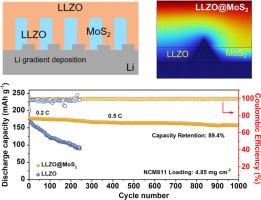一种具有离子导电和电子绝缘界面的janus型缓冲层,使无枝晶固态锂金属电池成为可能
IF 20.2
1区 材料科学
Q1 CHEMISTRY, PHYSICAL
引用次数: 0
摘要
石榴石基固态锂金属电池的循环寿命受到界面锂沉积行为的限制。在这项研究中,我们提出了一种创新的电解质-锂阳极界面缓冲层,将界面动力学与锂金属相容性结合起来。成功研制了一种具有离子传递和电子绝缘双重功能的非均相纳米纤维缓冲层LLZO@MoS2,有效调节了界面电位分布,保证了锂离子的均匀沉积。同时,利用LLZO@MoS2-CPI非均相纳米纤维优化锂金属表面电位分布。该设计利用增强的界面兼容性,有效地减轻了从Li到LLZO晶界/缺陷的电子泄漏,优化了Li+输运动力学,从而提高了高电流密度下的循环稳定性。独特的缓冲层可实现1.5 mA cm−2的临界电流密度(CCD)。所得到的对称电池在实际电流密度为0.8 mA cm−2时具有令人印象深刻的2000 h循环寿命。当与各种阴极配对时,它提供稳定和高度可逆的容量。具体来说,组装的NCM811电池在0.1 C时具有188 mAh g−1的高可逆容量,在0.5 C时具有1000次循环的良好循环稳定性。这一发现打破了传统的旨在提高LLZO基复合电解质(LLZO CSE)固态锂金属电池整体性能的策略,并显着优化了循环过程中的锂沉积行为。本文章由计算机程序翻译,如有差异,请以英文原文为准。


An Janus-type buffer layer with ion conductive and electron insulative interface enabling dendrite-free solid-state lithium metal batteries
The cycle life of garnet-based solid-state lithium-metal batteries is limited by interfacial lithium deposition behaviour. In this study, we propose an innovative buffer layer for the electrolyte-lithium anode interface that combined interfacial dynamics with lithium-metal compatibility. A heterogeneous nanofiber buffer layer of LLZO@MoS2, possessing bifunctional ion transport and electronic insulation, has been successfully developed, effectively regulating the potential distribution at the interface to ensure uniform lithium ion deposition. Meanwhile, LLZO@MoS2composite polymer intermediate layer heterogeneous nanofibers is employed to optimize potential distribution on the lithium metal surface. This design leverages enhanced interfacial compatibility to effectively mitigate electron leakage from Li to LLZO grain boundaries/defects, optimize Li+ transport kinetics, and consequently improve cycling stability at high current densities. The unique buffer layer enables a critical current density (CCD) of 1.5 mA cm−2. The resulting symmetric cells exhibit an impressive 2000 h cycle life at a practical current density of 0.8 mA cm−2. When paired with a variety of cathodes, it provides stable and highly reversible capacity. Specifically, the assembled NCM811 cell has a highly reversible capacity of 188 mAh g−1 at 0.1 C and a good cycle stability of 1000 cycles at 0.5 C. This finding breaks with conventional strategies aimed at improving the overall performance of solid-state lithium-metal batteries with LLZO-based composite electrolytes (LLZO CSE) and significantly optimises the lithium deposition behaviour during cycling.
求助全文
通过发布文献求助,成功后即可免费获取论文全文。
去求助
来源期刊

Energy Storage Materials
Materials Science-General Materials Science
CiteScore
33.00
自引率
5.90%
发文量
652
审稿时长
27 days
期刊介绍:
Energy Storage Materials is a global interdisciplinary journal dedicated to sharing scientific and technological advancements in materials and devices for advanced energy storage and related energy conversion, such as in metal-O2 batteries. The journal features comprehensive research articles, including full papers and short communications, as well as authoritative feature articles and reviews by leading experts in the field.
Energy Storage Materials covers a wide range of topics, including the synthesis, fabrication, structure, properties, performance, and technological applications of energy storage materials. Additionally, the journal explores strategies, policies, and developments in the field of energy storage materials and devices for sustainable energy.
Published papers are selected based on their scientific and technological significance, their ability to provide valuable new knowledge, and their relevance to the international research community.
 求助内容:
求助内容: 应助结果提醒方式:
应助结果提醒方式:


